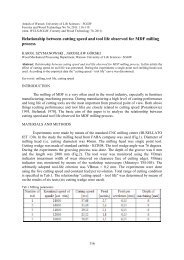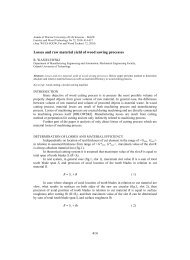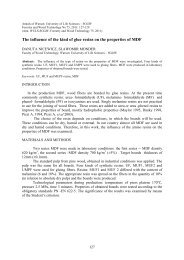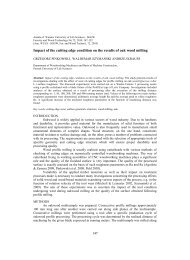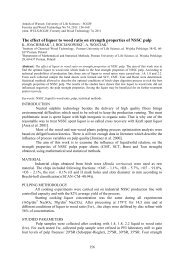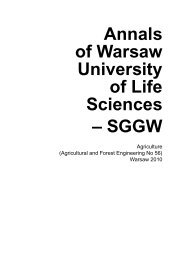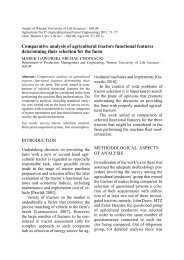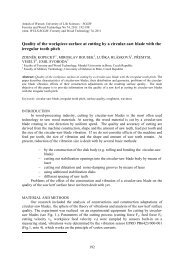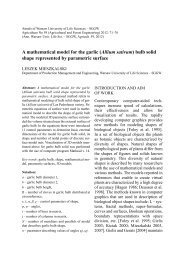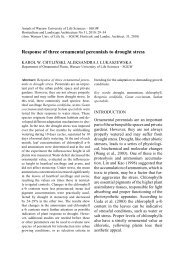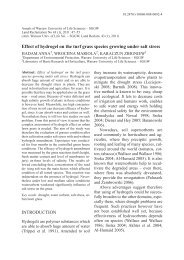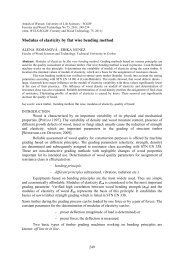Annals of Warsaw University of Life Sciences - SGGW
Annals of Warsaw University of Life Sciences - SGGW
Annals of Warsaw University of Life Sciences - SGGW
Create successful ePaper yourself
Turn your PDF publications into a flip-book with our unique Google optimized e-Paper software.
6<br />
5<br />
4<br />
Fiber direction - cross<br />
Ra before mechanical w orking<br />
Ra after Finishing treatment<br />
Ra after mechanical w orking<br />
Ra [μm]<br />
3<br />
2<br />
1<br />
0<br />
Wood milling Sanding L1 - Thermomechanic<br />
pressing<br />
m echanical w orking<br />
L2 - Thermomechanic<br />
pressing<br />
L3 - Thermomechanic<br />
pressing<br />
Fig.3: Mean arithmetic deviation <strong>of</strong> the pr<strong>of</strong>ile Ra, by different mechanical surface treatment <strong>of</strong> wood<br />
The 4-factor statistical scatter analysis <strong>of</strong> the measured Ra characteristics supports<br />
the theories <strong>of</strong> Gáborík, Žitný (2007), Jourdain et al. (1999), Kúdela et al. (2004), Liptáková,<br />
Kúdela (2000), Móza (2007) which claim that the anatomical direction influences quality <strong>of</strong><br />
wood surface (i.e. its roughness, too) to a great extent. The analysis also supported the theory<br />
<strong>of</strong> Liptáková, Kúdela (2000) which compares milled, sanded, microtome- and hydroknifeprocessed<br />
wood surfaces and proves that different surface processing has a significant impact<br />
on the wood surface roughness. To broaden the spectrum, our study has focused on<br />
comparison <strong>of</strong> milled, sanded and pressed surfaces.<br />
From results <strong>of</strong> statistic evaluation it results, that on resultant roughness surface<br />
making- up by water the diluting texture cloth has a very statistically prominent influence:<br />
- interaction between the mechanical wrought and the direction <strong>of</strong> libriforming fibre,<br />
- interaction between the mechanical wrought, type <strong>of</strong> the texture cloth and the<br />
thickness texture film,<br />
- interaction between the mechanical wrought <strong>of</strong> the surface wood, the texture cloth, the<br />
thickness <strong>of</strong> texture film and the direction <strong>of</strong> wood fibres.<br />
Thickness <strong>of</strong> the paint coating film H1<br />
Coating P1<br />
Coating P2<br />
4<br />
3,5<br />
3<br />
Ra [μm]<br />
2,5<br />
2<br />
1,5<br />
1<br />
0,5<br />
0<br />
Wood milling Sanding L1 - Thermomechanic<br />
pressing<br />
L2 - Thermomechanic<br />
pressing<br />
L3 - Thermomechanic<br />
pressing<br />
m echanical w orking<br />
Fig.4: Mean arithmetic deviation <strong>of</strong> the pr<strong>of</strong>ile Ra (measured after finishing treatment), by different mechanical<br />
surface treatment <strong>of</strong> wood for selected types <strong>of</strong> coating materials<br />
31



